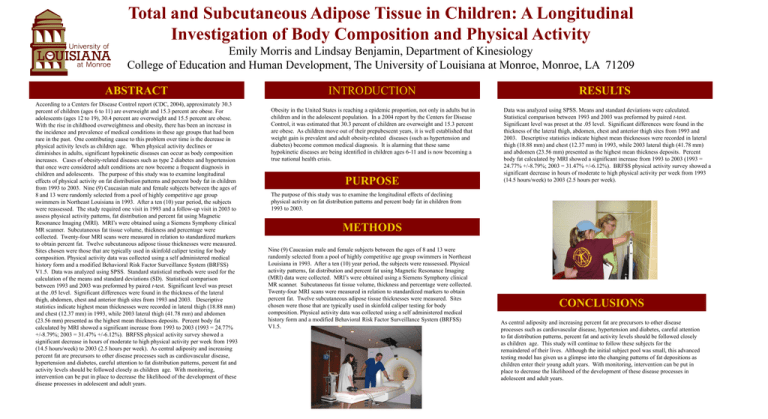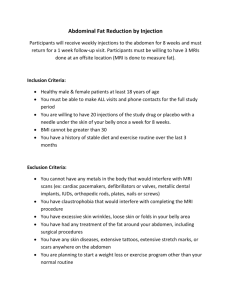Total and Subcutaneous Adipose Tissue in Children: A Longitudinal
advertisement

Total and Subcutaneous Adipose Tissue in Children: A Longitudinal Investigation of Body Composition and Physical Activity Emily Morris and Lindsay Benjamin, Department of Kinesiology College of Education and Human Development, The University of Louisiana at Monroe, Monroe, LA 71209 ABSTRACT According to a Centers for Disease Control report (CDC, 2004), approximately 30.3 percent of children (ages 6 to 11) are overweight and 15.3 percent are obese. For adolescents (ages 12 to 19), 30.4 percent are overweight and 15.5 percent are obese. With the rise in childhood overweightness and obesity, there has been an increase in the incidence and prevalence of medical conditions in these age groups that had been rare in the past. One contributing cause to this problem over time is the decrease in physical activity levels as children age. When physical activity declines or diminishes in adults, significant hypokinetic diseases can occur as body composition increases. Cases of obesity-related diseases such as type 2 diabetes and hypertension that once were considered adult conditions are now become a frequent diagnosis in children and adolescents. The purpose of this study was to examine longitudinal effects of physical activity on fat distribution patterns and percent body fat in children from 1993 to 2003. Nine (9) Caucasian male and female subjects between the ages of 8 and 13 were randomly selected from a pool of highly competitive age group swimmers in Northeast Louisiana in 1993. After a ten (10) year period, the subjects were reassessed. The study required one visit in 1993 and a follow-up visit in 2003 to assess physical activity patterns, fat distribution and percent fat using Magnetic Resonance Imaging (MRI). MRI’s were obtained using a Siemens Symphony clinical MR scanner. Subcutaneous fat tissue volume, thickness and percentage were collected. Twenty-four MRI scans were measured in relation to standardized markers to obtain percent fat. Twelve subcutaneous adipose tissue thicknesses were measured. Sites chosen were those that are typically used in skinfold caliper testing for body composition. Physical activity data was collected using a self administered medical history form and a modified Behavioral Risk Factor Surveillance System (BRFSS) V1.5. Data was analyzed using SPSS. Standard statistical methods were used for the calculation of the means and standard deviations (SD). Statistical comparison between 1993 and 2003 was preformed by paired t-test. Significant level was preset at the .05 level. Significant differences were found in the thickness of the lateral thigh, abdomen, chest and anterior thigh sites from 1993 and 2003. Descriptive statistics indicate highest mean thicknesses were recorded in lateral thigh (18.88 mm) and chest (12.37 mm) in 1993, while 2003 lateral thigh (41.78 mm) and abdomen (23.56 mm) presented as the highest mean thickness deposits. Percent body fat calculated by MRI showed a significant increase from 1993 to 2003 (1993 = 24.77% +/-8.79%; 2003 = 31.47% +/-6.12%). BRFSS physical activity survey showed a significant decrease in hours of moderate to high physical activity per week from 1993 (14.5 hours/week) to 2003 (2.5 hours per week). As central adiposity and increasing percent fat are precursors to other disease processes such as cardiovascular disease, hypertension and diabetes, careful attention to fat distribution patterns, percent fat and activity levels should be followed closely as children age. With monitoring, intervention can be put in place to decrease the likelihood of the development of these disease processes in adolescent and adult years. INTRODUCTION Obesity in the United States is reaching a epidemic proportion, not only in adults but in children and in the adolescent population. In a 2004 report by the Centers for Disease Control, it was estimated that 30.3 percent of children are overweight and 15.3 percent are obese. As children move out of their prepubescent years, it is well established that weight gain is prevalent and adult obesity-related diseases (such as hypertension and diabetes) become common medical diagnosis. It is alarming that these same hypokinetic diseases are being identified in children ages 6-11 and is now becoming a true national health crisis. PURPOSE RESULTS Data was analyzed using SPSS. Means and standard deviations were calculated. Statistical comparison between 1993 and 2003 was preformed by paired t-test. Significant level was preset at the .05 level. Significant differences were found in the thickness of the lateral thigh, abdomen, chest and anterior thigh sites from 1993 and 2003. Descriptive statistics indicate highest mean thicknesses were recorded in lateral thigh (18.88 mm) and chest (12.37 mm) in 1993, while 2003 lateral thigh (41.78 mm) and abdomen (23.56 mm) presented as the highest mean thickness deposits. Percent body fat calculated by MRI showed a significant increase from 1993 to 2003 (1993 = 24.77% +/-8.79%; 2003 = 31.47% +/-6.12%). BRFSS physical activity survey showed a significant decrease in hours of moderate to high physical activity per week from 1993 (14.5 hours/week) to 2003 (2.5 hours per week). The purpose of this study was to examine the longitudinal effects of declining physical activity on fat distribution patterns and percent body fat in children from 1993 to 2003. METHODS Nine (9) Caucasian male and female subjects between the ages of 8 and 13 were randomly selected from a pool of highly competitive age group swimmers in Northeast Louisiana in 1993. After a ten (10) year period, the subjects were reassessed. Physical activity patterns, fat distribution and percent fat using Magnetic Resonance Imaging (MRI) data were collected. MRI’s were obtained using a Siemens Symphony clinical MR scanner. Subcutaneous fat tissue volume, thickness and percentage were collected. Twenty-four MRI scans were measured in relation to standardized markers to obtain percent fat. Twelve subcutaneous adipose tissue thicknesses were measured. Sites chosen were those that are typically used in skinfold caliper testing for body composition. Physical activity data was collected using a self administered medical history form and a modified Behavioral Risk Factor Surveillance System (BRFSS) V1.5. CONCLUSIONS As central adiposity and increasing percent fat are precursors to other disease processes such as cardiovascular disease, hypertension and diabetes, careful attention to fat distribution patterns, percent fat and activity levels should be followed closely as children age. This study will continue to follow these subjects for the remaindered of their lives. Although the initial subject pool was small, this advanced testing model has given us a glimpse into the changing patterns of fat depositions as children enter their young adult years. With monitoring, intervention can be put in place to decrease the likelihood of the development of these disease processes in adolescent and adult years.



